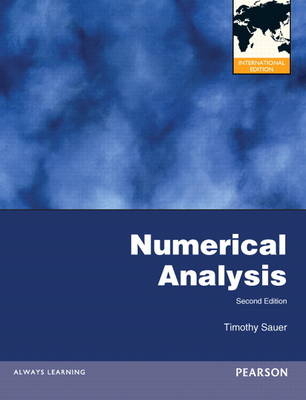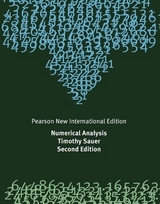
Numerical Analysis
Pearson (Verlag)
978-0-321-81876-8 (ISBN)
- Titel erscheint in neuer Auflage
- Artikel merken
Timothy Sauer earned his Ph.D. in mathematics at the University of California–Berkeley in 1982, and is currently a professor at George Mason University. He has published articles on a wide range of topics in applied mathematics, including dynamical systems, computational mathematics, and mathematical biology.
Preface
0. Fundamentals
0.1 Evaluating a polynomial
0.2 Binary numbers
0.2.1 Decimal to binary
0.2.2 Binary to decimal
0.3 Floating point representation of real numbers
0.3.1 Floating point formats
0.3.2 Machine representation
0.3.3 Addition of floating point numbers
0.4 Loss of significance
0.5 Review of calculus
0.6 Software and Further Reading
1. Solving Equations
1.1 The Bisection Method
1.1.1 Bracketing a root
1.1.2 How accurate and how fast?
1.2 Fixed point iteration
1.2.1 Fixed points of a function
1.2.2 Geometry of Fixed Point Iteration
1.2.3 Linear Convergence of Fixed Point Iteration
1.2.4 Stopping criteria
1.3 Limits of accuracy
1.3.1 Forward and backward error
1.3.2 The Wilkinson polynomial
1.3.3 Sensitivity and error magnification
1.4 Newton’s Method
1.4.1 Quadratic convergence of Newton's method
1.4.2 Linear convergence of Newton's method
1.5 Root-finding without derivatives
1.5.1 Secant method and variants
1.5.2 Brent's Method
REALITY CHECK 1: Kinematics of the Stewart platform
1.6 Software and Further Reading
2. Systems of Equations
2.1 Gaussian elimination
2.1.1 Naive Gaussian elimination
2.1.2 Operation counts
2.2 The LU factorization
2.2.1 Backsolving with the LU factorization
2.2.2 Complexity of the LU factorization
2.3 Sources of error
2.3.1 Error magnification and condition number
2.3.2 Swamping
2.4 The PA=LU factorization
2.4.1 Partial pivoting
2.4.2 Permutation matrices
2.4.3 PA = LU factorization
REALITY CHECK 2: The Euler-Bernoulli Beam
2.5 Iterative methods
2.5.1 Jacobi Method
2.5.2 Gauss-Seidel Method and SOR
2.5.3 Convergence of iterative methods
2.5.4 Sparse matrix computations
2.6 Methods for symmetric positive-definite matrices
2.6.1 Symmetric positive-definite matrices
2.6.2 Cholesky factorization
2.6.3 Conjugate Gradient Method
2.6.4 Preconditioning
2.7 Nonlinear systems of equations
2.7.1 Multivariate Newton's method
2.7.2 Broyden's method
2.8 Software and Further Reading
3. Interpolation
3.1 Data and interpolating functions
3.1.1 Lagrange interpolation
3.1.2 Newton's divided differences
3.1.3 How many degree d polynomials pass through n points?
3.1.4 Code for interpolation
3.1.5 Representing functions by approximating polynomials
3.2 Interpolation error
3.2.1 Interpolation error formula
3.2.2 Proof of Newton form and error formula
3.2.3 Runge phenomenon
3.3 Chebyshev interpolation
3.3.1 Chebyshev's Theorem
3.3.2 Chebyshev polynomials
3.3.3 Change of interval
3.4 Cubic splines
3.4.1 Properties of splines
3.4.2 Endpoint conditions
3.5 Bézier curves
REALITY CHECK 3: Constructing fonts from Bézier splines
3.6 Software and Further Reading
4. Least Squares
4.1 Least squares and the normal equations
4.1.1 Inconsistent systems of equations
4.1.2 Fitting models to data
4.2 Linear and nonlinear models
4.1.3 Conditioning of least squares
4.2 A survey of models
4.2.1 Periodic data
4.2.2 Data linearization
4.3 QR factorization
4.3.1 Gram-Schmidt orthogonalization and least squares
4.3.2 Modified Gram-Schmidt orthogonalization
4.3.3 Householder reflectors
4.4 Generalized Minimum Residual (GMRES) Method
4.4.1 Krylov methods
4.4.2 Preconditioned GMRES
4.5 Nonlinear least squares
4.5.1 Gauss-Newton method
4.5.2 Models with nonlinear parameters
4.5.3 Levenberg-Marquardt method
REALITY CHECK 4: GPS, conditioning and nonlinear least squares
4.6 Software and Further Reading
5. Numerical Differentiation and Integration
5.1 Numerical differentiation
5.1.1 Finite difference formulas
5.1.2 Rounding error
5.1.3 Extrapolation
5.1.4 Symbolic differentiation and integration
5.2 Newton-Cotes formulas for numerical integration
5.2.1 Trapezoid rule
5.2.2 Simpson's Rule
5.2.3 Composite Newton-Cotes Formulas
5.2.4 Open Newton-Cotes methods
5.3 Romberg integration
5.4 Adaptive quadrature
5.5 Gaussian quadrature
REALITY CHECK 5: Motion control in computer-aided modelling
5.6 Software and Further Reading
6. Ordinary Differential Equations
6.1 Initial value problems
6.1.1 Euler's method
6.1.2 Existence, uniqueness, and continuity for solutions
6.1.3 First-order linear equations
6.2 Analysis of IVP solvers
6.2.1 Local and global truncation error
6.2.2 The explicit trapezoid method
6.2.3 Taylor methods
6.3 Systems of ordinary differential equations
6.3.1 Higher order equations
6.3.2 Computer simulation: The pendulum
6.3.3 Computer simulation: Orbital mechanics
6.4 Runge-Kutta methods and applications
6.4.1 The Runge-Kutta family
6.4.2 Computer simulation: The Hodgkin-Huxley neuron
6.4.3 Computer simulation: The Lorenz equations
REALITY CHECK 6: The Tacoma Narrows Bridge
6.5 Variable step-size methods
6.5.1 Embedded Runge-Kutta pairs
6.5.2 Order 4/5 methods
6.6 Implicit methods and stiff equations
6.7 Multistep methods
6.7.1 Generating multistep methods
6.7.2 Explicit multistep methods
6.7.3 Implicit multistep methods
6.8 Software and Further Reading
7. Boundary Value Problems
7.1 Shooting method
7.1.1 Solutions of boundary value problems
7.1.2 Shooting method implementation
REALITY CHECK 7: Buckling of a circular ring
7.2 Finite difference methods
7.2.1 Linear boundary value problems
7.2.2 Nonlinear boundary value problems
7.3 Collocation and the Finite Element Method
7.3.1 Collocation
7.3.2 Finite elements and the Galerkin method
7.4 Software and Further Reading
8. Partial Differential Equations
8.1 Parabolic equations
8.1.1 Forward difference method
8.1.2 Stability analysis of forward difference method
8.1.3 Backward difference method
8.1.4 Crank-Nicolson method
8.2 Hyperbolic equations
8.2.1 The wave equation
8.2.2 The CFL condition
8.3 Elliptic equations
8.3.1 Finite difference method for elliptic equations
REALITY CHECK 8: Heat distribution on a cooling fin
8.3.2 Finite element method for elliptic equations
8.4 Nonlinear partial differential equations
8.4.1 Implicit Newton solver
8.4.2 Nonlinear equations in two space dimensions
8.5 Software and Further Reading
9. Random Numbers and Applications
9.1 Random numbers
9.1.1 Pseudo-random numbers
9.1.2 Exponential and normal random numbers
9.2 Monte-Carlo simulation
9.2.1 Power laws for Monte Carlo estimation
9.2.2 Quasi-random numbers
9.3 Discrete and continuous Brownian motion
9.3.1 Random walks
9.3.2 Continuous Brownian motion
9.4 Stochastic differential equations
9.4.1 Adding noise to differential equations
9.4.2 Numerical methods for SDEs
REALITY CHECK 9: The Black-Scholes formula
9.5 Software and Further Reading
10. Trigonometric Interpolation and the FFT
10.1 The Fourier Transform
10.1.1 Complex arithmetic
10.1.2 Discrete Fourier Transform
10.1.3 The Fast Fourier Transform
10.2 Trigonometric interpolation
10.2.1 The DFT Interpolation Theorem
10.2.2 Efficient evaluation of trigonometric functions
10.3 The FFT and signal processing
10.3.1 Orthogonality and interpolation
10.3.2 Least squares fitting with trigonometric functions
10.3.3 Sound, noise, and filtering
REALITY CHECK 10: The Wiener filter
10.4 Software and Further Reading
11. Compression
11.1 The Discrete Cosine Transform
11.1.1 One-dimensional DCT
11.1.2 The DCT and least squares approximation
11.2 Two-dimensional DCT and image compression
11.2.1 Two-dimensional DCT
11.2.2 Image compression
11.2.3 Quantization
11.3 Huffman coding
11.3.1 Information theory and coding
11.3.2 Huffman coding for the JPEG format
11.4 Modified DCT and audio compression
11.4.1 Modified Discrete Cosine Transform
11.4.2 Bit quantization
REALITY CHECK 11: A simple audio codec using the MDCT
11.5 Software and Further Reading
12. Eigenvalues and Singular Values
12.1 Power iteration methods
12.1.1 Power iteration
12.1.2 Convergence of power iteration
12.1.3 Inverse power iteration
12.1.4 Rayleigh quotient iteration
12.2 QR algorithm
12.2.1 Simultaneous iteration
12.2.2 Real Schur form and QR
12.2.3 Upper Hessenberg form
REALITY CHECK 12: How search engines rate page quality
12.3 Singular value decomposition
12.3.1 Finding the SVD in general
12.3.2 Special case: symmetric matrices
12.4 Applications of the SVD
12.4.1 Properties of the SVD
12.4.2 Dimension reduction
12.4.3 Compression
12.4.4 Calculating the SVD
12.5 Software and Further Reading
13. Optimization
13.1 Unconstrained optimization without derivatives
13.1.1 Golden section search
13.1.2 Successive parabolic interpolation
13.1.3 Nelder-Mead search
13.2 Unconstrained optimization with derivatives
13.2.1 Newton's method
13.2.2 Steepest descent
13.2.3 Conjugate gradient search
13.2.4 Nonlinear least squares
REALITY CHECK 13: Molecular conformation and numerical optimization
13.3 Software and Further Reading
APPENDIX
Appendix A: Matrix Algebra
A.1 Matrix fundamentals
A.2 Block multiplication
A.3 Eigenvalues and eigenvectors
A.4 Symmetric matrices
A.5 Vector calculus
Appendix B: Introduction to MATLAB
B.1 Starting MATLAB
B.2 MATLAB graphics
B.3 Programming in MATLAB
B.4 Flow control
B.5 Functions
B.6 Matrix operations
B.7 Animation and movies
References
| Erscheint lt. Verlag | 14.12.2011 |
|---|---|
| Sprache | englisch |
| Maße | 205 x 253 mm |
| Gewicht | 1040 g |
| Themenwelt | Mathematik / Informatik ► Mathematik ► Analysis |
| ISBN-10 | 0-321-81876-8 / 0321818768 |
| ISBN-13 | 978-0-321-81876-8 / 9780321818768 |
| Zustand | Neuware |
| Informationen gemäß Produktsicherheitsverordnung (GPSR) | |
| Haben Sie eine Frage zum Produkt? |
aus dem Bereich



